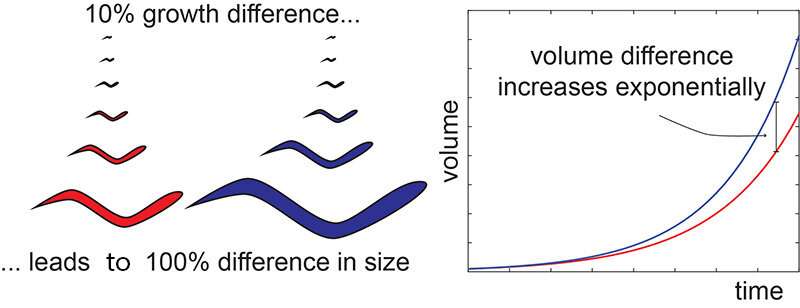How animals reach their correct size

Even small differences in how fast animals grow during development can sum up to large differences in their adult body size. Nevertheless, adults of the same species are usually nearly identical in size. Benjamin Towbin, a postdoc in the Grosshans lab who is now at Uni Bern, discovered a mechanism that promotes such size uniformity without measuring size itself. His research using C. elegans showed that the speed of growth determines the speed of a genetic clock that times development.
By and large, individuals of the same species grow to the same size. This uniformity in size is astounding, since intrinsic randomness in developmental processes and in environmental conditions produce substantial differences in how fast individuals grow. Moreover, because animal growth is often exponential, even small differences in growth can amplify to large differences in size. How do animals nevertheless make sure to reach the correct size?
Although size control has been extensively studied in unicellular microbes, little is known on how multicellular animals control their size. Benjamin Towbin, now an Assistant Professor at the University of Bern, was an expert in bacterial size control when he joined the FMI as a postdoc in the group of Helge Grosshans. He realized that the new live imaging technology that the Grosshans lab used to record development of the roundworm C. elegans opened new opportunities to study how animals control their size.
In a study published in Nature Communications, Towbin used time-lapse microscopy to record hundreds of individual C. elegans from hatching to adulthood. Towbin discovered a mechanism that ensures the uniformity of body size among individual animals. The mechanism does not appear to measure size per se. Instead, it senses how fast an individual grows and appropriately adjusts the time after which this individual turns adult. Therefore, a slowly growing individual reaches the same size as a rapidly growing individual because it is given more time to grow.

Towbin showed that this mechanism occurs by coupling the growth rate to the frequency of a so-called genetic oscillator. The Grosshans lab had previously shown that this oscillator functions as a developmental clock, see story. After four oscillations, juvenile development ends, and animals turn adult. Knowing this, Towbin used molecular tools to speed up this clock. As Towbin predicted by a mathematical model, animals with a faster clock turned adult more quickly and were smaller in size.
"The mathematical model also shows that an inverse relation of the growth rate and the oscillation frequency is not specific to worms, but a general property of genetic oscillators", says Towbin who is last author on the paper (Klement Stojanovski, the lab manager of his current lab, is first author). "Coupling of growth and development as found in the worm may thus underlie many other cases of biological size control," he says. For example, development of the spine of vertebrates also involves a genetic oscillator, whose coupling to growth may ensure the correct size and number of vertebrae.
More information: Klement Stojanovski et al, Coupling of growth rate and developmental tempo reduces body size heterogeneity in C. elegans, Nature Communications (2022). DOI: 10.1038/s41467-022-29720-8
Journal information: Nature Communications


















